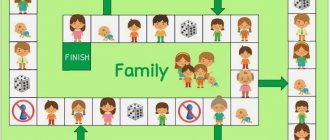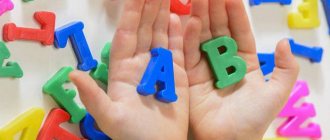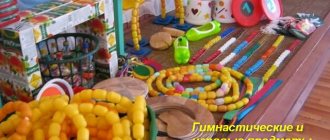Dear visitors of the site www.englishhobby.ru! On this page you will find materials on the following topics: English for children. English lessons in kindergarten. English for children. English at preschool educational institution. English for kids. Playful English for kids. English for kids download. Playful English for kids for free. Download free English for kids. Children's first English lesson. First English lessons + for kids. First English lesson + for kids. First English lessons + for kids. English lessons for kids first lessons. Crossword puzzle “Australia” in English.
Senior group. Senior preschool age. Children 5-6 years old
Project for children of senior preschool age “Magic world of English” (“Magic world of English”) The study of English in recent decades has entered the lives of children as one of the integral parts of their lives: the child hears foreign speech in the media, traveling abroad, using On the Internet, he sees English words in advertising and on store signs. In modern society…
Didactic games in English for children of the senior group Game “Feathers. Feathers” on the topic “Colors. Colors"
Children attach colored feathers to the bird, naming the color. “White feather, white feather, what do you see?” (place the white feather on the turkey's back) "I see a gold feather next to me." (place the gold feather on the turkey's back)…
Foreign from kindergarten - is it necessary?
Today no one doubts that knowledge of a foreign language is necessary and important. In schools, a foreign language is studied from primary school. It is even proposed to introduce a mandatory final exam in a foreign language. In many preschool educational institutions and various centers, children are introduced to a foreign language from an early age.
In September 2013, the first specialized English kindergarten was opened in Kostroma, at the request of parents. The city education department supported this initiative and developed a pilot project “English for preschoolers”. The partial program for teaching children 4-5 years old a foreign language is designed for three years. It is expected that by the time they leave kindergarten, most children will be able to communicate fluently not only in Russian, but also in English.
Many parents send their children to foreign language courses almost from birth. At the same time, other parents believe that an early start to learning a foreign language is harmful because it “deprives the child of a carefree childhood.”
There is no consensus among scientists either. The problems of teaching a foreign language to young children have not been fully resolved either in our country or abroad. At the same time, some believe that we can talk about early learning only if we are talking about introducing preschool children to a foreign language. Others believe that early learning of a foreign language means teaching children of primary school age.
A little history
The issue of early teaching of foreign languages arose in the 19th century. It was then that the methodology of early teaching of foreign languages began to emerge as a branch of methodological science. According to the testimony of contemporaries, in our country in the 19th century it was possible to meet a child who spoke three foreign languages fluently: French, English, and German. Teaching languages to 5-10 year old children of the affluent population was widespread.
In 1987, the board of the Ministry of Education of the RSFSR decided to conduct an experiment on teaching foreign languages to children of four years of age (studying in kindergarten) and six years of age (studying in the first grade of secondary school) on the basis of a school or kindergarten. The experiment involved tens of thousands of children. Hundreds of teachers and kindergarten teachers took part in it.
"Pros and cons"
Proponents of early foreign language teaching believe that learning foreign languages in early childhood is useful and effective. Preschool age is an excellent time to start learning languages, since a clear awareness of the difference between his native language and a foreign language has not yet taken root in the child’s mind. A child’s consciousness absorbs new knowledge like a sponge, and after a short time the baby no longer pays attention to the fact that everyone around him does not speak Russian! The most important advantage of such training is the overall educational effect. Parallel learning of two languages develops a child’s mental abilities. Knowledge and study of foreign languages have a beneficial effect on the emotional and moral development of a child, the development of attention, memory, imagination and imaginative thinking. It also stimulates the child’s general speech abilities, which has a beneficial effect on proficiency in the native language.
Those who are against early learning of a foreign language suggest that there is no point in learning a language so early that it is difficult for children, since it can lead to overwork and illness. The main thing is that parents cannot help their children because they do not speak a foreign language. Because if there is no language environment, language skills are quickly lost.
Most teachers and psychologists unanimously agree that learning a foreign language at the age of 5-6 years is unjustified. The question is, then why? But this is where parental ambitions play the main role: every decent kindergarten should teach a foreign language.
From what age?
There is also no clear answer to this question. In domestic and foreign psychology there is evidence that a preschool child masters a foreign language more easily than an adult. However, the duration of the sensitive (most favorable) period for mastering a foreign language is characterized differently by different authors: for example, V. Penfield and R. Roberts define it from 4 to 8 years, and T. Eliot - from 1.5 to 7 years.
Research shows that a child up to eight or nine years of age is a natural expert at mastering speech, but then the speech mechanisms in the brain gradually become less flexible. After the age of ten, one already has to overcome many obstacles caused by natural causes.
Most researchers agree that special foreign language classes can be conducted with children starting from three years old. It makes no sense to do this before the age of three, and when starting to learn a foreign language after ten years, it is already useless to hope for a positive result. Upon reaching this age, it is possible only for a small part of students - namely for those who have language abilities above the average level.
According to scientists, the period of highest “linguistic giftedness” is the fifth year of a child’s life. Thus, they believe, it is best to start learning a foreign language at the age of 4-6, when the child has already mastered the system of his native language quite well, and he treats the new language consciously and seriously.
It is at this age that the child still has few cliches of speech behavior, it is easy for him to “encode” his thoughts in a new way, and he does not experience difficulties when making contact in a foreign language. If the system of teaching a foreign language is structured correctly, then success in mastering a foreign language and creating the necessary prerequisites for further mastery of any language is guaranteed to almost all children.
However, it is still not possible to accurately determine the age at which all children can begin to learn a foreign language, since the psychological prerequisites for its acquisition are formed differently in different children. L.N. Tolstoy also wrote: “Teach children only when their psyche is ready for learning.”
Expert advice
First of all, parents themselves need to understand what goal they are pursuing by sending their child to learn a foreign language. Language learning should be meaningful. The few dozen words children learn during classes will not remain in the child’s memory for long. This kind of knowledge is based on mechanical memory, therefore it is short-term and quickly forgotten.
Learning a foreign language should begin when the child has mastered his native language.
Before you send your child to an early learning foreign language group or find him a teacher, look at his characteristics: is he ready for learning, even in the form of a game; Will he be interested in a foreign language or will he be more interested in drawing or football? Particular attention should be paid to the level of development of the child’s speech in his native language. If your child does not yet pronounce the sounds of his native language clearly enough and is confused about cases and declensions, then it is hardly worth loading him with foreign grammar. Wait a year or two, get rid of speech therapy problems, teach your child to speak their native language beautifully and correctly, and then learning a foreign language will be easier and more effective.
To learn a language, it is necessary to create an appropriate language environment: it is advisable that the whole family speaks the correct foreign language for several hours a day. If this is not possible, you can use audio recordings with songs and poems in a foreign language.
If you have invited a teacher to your child’s home to study the language, ask, first of all, if he has experience working with young children, ask a specialist to objectively assess the child’s knowledge and level of development of his native language.
In preschool age, experts believe, learning a foreign language is allowed if the child’s age characteristics and desires are taken into account and the principle: “Do no harm!” is observed.
In preparation, materials from Internet sites on this topic were used.
What is bilingualism and who are bilinguals?
Let me give you a little theory:
Bilingualism, or bilingualism, is the ability of a person to use two languages as native ones. Bilinguals can move freely from one language to another and have native-level proficiency in both languages. A very valuable skill, don’t you think?
For countries with several official languages, bilingualism is considered quite common. For example, Switzerland... Ah, Switzerland! Mr Great still can’t forget our trip to Gruyères, they make excellent cheese, I must say! But let's not get distracted! This country has four official languages, the majority of the population speaks at least two of them. Children learn languages in kindergartens, schools, and when communicating with peers in everyday life.
Why Switzerland, why go far - remember the experience of the Soviet Union in terms of bilingualism. In the USSR, Russian was the state language, however, in each of the republics there was bilingual education, and two languages were taught in schools - Russian and native. Soviet schoolchildren from the union republics and their parents didn’t even see anything special in their bilingualism, can you imagine?
How classes are conducted: main types of training
Bilingual educational institutions conduct classes using one of two methods:
- meaningful;
- subject.
It’s easy to understand how they differ!
In a content-based approach, equal amounts of time are allocated to teaching in both languages. Moreover, all mental processes (memory, attention, thinking, speech) develop in two languages. This contributes to the formation of a bilingual personality; the child assimilates both linguistic cultures and learns to think in two languages. Just imagine what opportunities this provides for the development of personality and horizons!
But the subject methodology is based on teaching one part of the disciplines in Russian, the other in English. Respected experts are of the opinion that with this technology of learning, the child does not become a full-fledged bilingual. The subject method does not develop full-fledged bilingual thinking, does not provide a complete understanding of culture, mentality and socio-cultural characteristics.
The educational process can also be structured in several ways:
- emphasis in studying Russian, mastering English as a second language;
- teaching in the native language with the later addition of a foreign language;
- studying in mixed groups with Russian-speaking and English-speaking children.
And of course, each of the methods involves the use of gaming methods. The children act out skits, sing songs, watch cartoons, and learn poetry and tongue twisters. In class, they study national holidays and culture of another country. Oh, with what pleasure our kids at Heritage School collect chocolate eggs for Easter! And on Halloween, what is going on here, God forgive me!
Bilingual kindergartens and schools are an investment in the child’s future
Bilingual education has many advantages over conventional education. Children master a foreign language as a second native language, broaden their horizons, and become familiar with the main components of Anglo-American culture. They have a high degree of adaptability to change, become tolerant and more easily integrate into a new society.
There are several bilingual preschool institutions in Moscow. The most famous of them:
- Heritage School is an international primary school and kindergarten, teaching according to the British Early Years Foundation Stage (EYFS) program and the Russian state school curriculum (and Mr Great and I cannot be happier that we chose this particular school for our children!);
- P'titCREF is a trilingual kindergarten that unites children who speak English, French and Russian.
- Baby-Bilingual Club - a club for early language development, provides complete immersion in the language environment;
- English Nursery & Primary School is a kindergarten and primary school that combines the best traditions of British and Russian education; education is conducted by immersion in an English-speaking environment.
To make sure you don’t make a mistake in your choice, I recommend using my husband’s proprietary checklist! This is what we were guided by when making our choice.
Mr Great checklist for choosing a bilingual kindergarten
- Find out what methodology the kindergarten uses (content-based or subject-based). I repeat, content is more effective;
- Ask about the teaching staff. It is important that most teachers are native speakers of a foreign language;
- Make sure that subject teachers do not change every month; a stable teaching staff is important, so you won’t have to worry that in the middle of the school year a native speaker teacher will not be replaced by a Russian-speaking colleague;
- Study the extracurricular life of the school, not only classes are important, but also the general atmosphere, cultural integration in an interlingual environment;
- Find out under what conditions the school building is used, this is important; it will be extremely inconvenient if, at the height of the school year, the school fails to renew the lease agreement, and the kindergarten will have to move to the other end of the city.
And most importantly, dear parents: when choosing a bilingual preschool for your child, take the trouble to attend a trial lesson. This will allow you to assess how suitable this kindergarten is for your child and meets its goals and objectives. Personal impressions are the most important!
Always yours, Mrs Britain
Key benefits of bilingual practice
To summarize, I will try to highlight for you the most important advantages that bilingual education has. So:
- communication skills develop;
- memory and logic are stimulated;
- vocabulary and conceptual stock expands.
A bilingual child studies the history and culture of both countries. He develops fluent spoken language and correct pronunciation, and instantly switches easily from one language to another. Bilingual children are special; as they get older, they have the ability to quickly change activities, concentrate better and can solve two problems at the same time. It’s a pleasure to watch such kids, I tell you!








